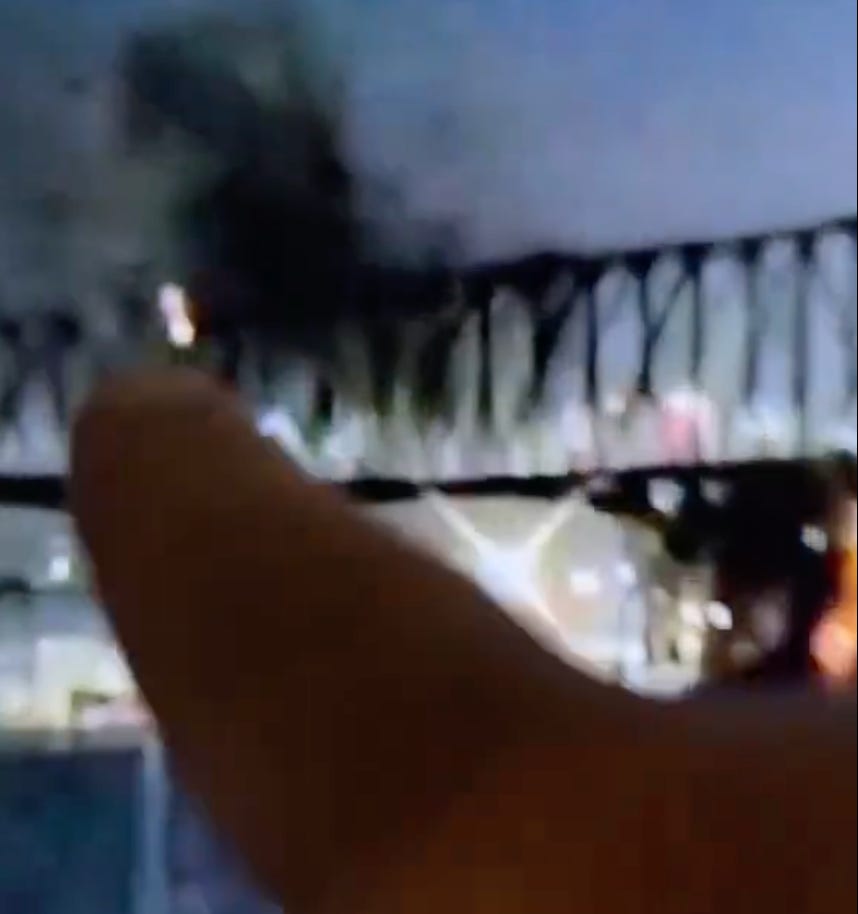The recent collision of the container ship Dali with the Francis Scott Key Bridge, managed by Synergy Marine Group, has spotlighted the vulnerabilities of critical infrastructure and maritime navigation, particularly during rising geopolitical maneuvers. This startling incident has not only cost up to six construction workers’ lives and immediately disrupted the flow of goods between Baltimore and Washington, D.C., but also raised alarms over the potential for digital manipulation in the shipping industry.
Moreover, the ship's accelerated and altered course, documented by AIS data just before the impact, ignites concerns about cargo ships' susceptibility to cyberattacks. These fears are compounded by reports of the vessel encountering power and steering gear problems shortly before the collision despite having cleared a Control of Compliance (COC) exam by the Coast Guard before its voyage to Sri Lanka.
The timing of the catastrophic incident is highly questionable, considering a recent announcement by the U.S. Department of State Diplomatic Security Service Rewards for Justice:
As the Port of Baltimore faces a potentially lengthy recovery period, this event's ramifications extend far beyond local economic disruptions. They highlight the broader challenges of safeguarding maritime routes against emerging digital and wartime threats. This incident is a stark reminder of the ever-present risks in a globally connected world, where maritime operations and critical infrastructure security remains perpetually at stake.
With a potential conflict in Europe, the Port of Baltimore is a strategic target due to its pivotal role in the United States' infrastructure. It is recognized as the largest U.S. port specializing in handling wheeled cargo, including trucks and trailers. It is equipped with advanced facilities designed to manage various types of cargo, such as roll-on/roll-off cargo ships to load tanks and tracked vehicles, aka, military vehicles.
This specialization underscores the port's critical importance in logistical and military readiness and highlights its potential vulnerability in the event of international hostilities.
In addition, two cargo ships on call to support U.S. military operations are trapped in the Port of Baltimore.
Just moments before the collision, as captured by the AIS data, the ship's course alteration and acceleration suggest a deliberate act rather than a mere accident. Theories propose that hackers could exploit vulnerabilities in unencrypted maritime communication systems, such as NMEA 0183, to hijack control of crucial functions ranging from GPS data to engine and rudder settings. The fact that this ship sped up and veered off its original course directly into the bridge's support lends weight to concerns over cyber threats that have been documented for over a decade.
The long-term implications of this event for the Port of Baltimore and its associated logistics and supply chains cannot be understated. This incident highlights the fragility of critical infrastructure and the evolving landscape of maritime security risks—particularly during growing geopolitical tensions.
CLEANING UP THE MESS, COVERING UP AN ATTACK?
Amidst the chaos, President Biden announced the federal government (aka taxpayers) would bear the entire cost of reconstructing the damaged bridge. This announcement has sparked a flurry of questions regarding the role of insurance and the principles of liability (no insurance, no investigation?), especially considering the magnitude of the destruction allegedly caused by a single vessel. And why the uncharacteristic federal assistance? No such assistance was available during the Ohio train derailment or the incineration of Lahaina.
Speaking of Lahaina, which is being advanced into a smart city, Baltimore has similar plans.
But I digress…..
The question of why the vessel's insurance company isn't contributing to the damages has been met with understandable outrage. The underlying issue centers on the distinction between accidents and deliberate acts. In instances where criminal activity is suspected, insurance policies often have clauses that exempt them from covering such acts, leading to years of entanglement in the courts. The shipping company involved, with its substantial financial clout, could feasibly cover the costs of the bridge's reconstruction, so why force US taxpayers to foot the bill?
Check out the most recent info on the Dali timeline, below:
In the aftermath of the bridge collapse, numerous questions remain unanswered. In pursuit of clarity, I have spent the past few days meticulously gathering the latest information. This effort aims to give readers a deeper understanding of the event's complexity, expose the vulnerabilities at play, and explore the potential for possible criminal involvement. Below are key insights that have emerged:
CYBERSECURITY & OTHER CONCERNS:
Due to continuous satellite connections for tracking and logistics, container ships are highly vulnerable to hacking.
The advanced convenience electronics onboard these ships make them susceptible to cyber attacks, which could allow hackers to control or even sink the ships by manipulating their systems.
Fuel contamination issues are the industry's dirty little secret and a widespread problem in the maritime industry. Because these incidents generally occur in open waters, they often go unreported or do not cause significant damage to vessels, property, or life. So, if this is not an attack, contaminated fuel may be the next suspect.
Ships managed by Synergy Marine Group have been involved in at least three deadly incidents since 2018
Observations indicate no attempt to throttle back or divert the ship, implying a deliberate action to hit the bridge. This suggests that it was not under human control but rather directed through hacking.
Speculations include using strategic explosives at the bridge's stress points to coincide with the ship's impact.
The crew first signaled trouble with the vessel when a pilot radioed for help from tugboats at about 1:26 a.m. ET Tuesday – just about three minutes before the ship hit the bridge column.
The investigation into the collision could take up to two years.
BROADER IMPLICATIONS:
This is a major U.S. infrastructure hit. The Port of Baltimore is the major port serving Baltimore and Washington, D.C. All of the shipping north of the bridge is now trapped in place. No other shipping can get in. The tunnel shown has height and hazardous cargo restrictions. It can't take the heavy trucking traffic that used the Francis Scott Key Bridge, which took YEARS to build back in the 1970s.
Goods currently in transit must be rerouted, which will cause delays and prevent ships from returning for new loads. This will disrupt routing for approximately the next month and a half.
This rerouting places significant additional pressure on an already strained container shipment system.
Port facilities, which require advance booking similar to airline reservations, will face increased pressure due to the changes in shipping routes and schedules.
The I-95 corridor on the eastern seaboard literally connects the north and south. It has completely destroyed one of the country's most important supply chains.
Many see the event as a cyber attack targeting a crucial infrastructure corridor in the United States. It specifically impacts the supply chain by hindering access to the Port of Baltimore and affecting the distribution of hazardous and flammable materials, fuel, nitrogen, chemicals, essential commodities, and oversized loads necessary for a robust economy, which will be shut down for at least four to five years.
There is serious speculation that this attack could be part of larger geopolitical tensions between Russia and the possibility of Ukraine, the UK, and the US's role in the terror attack in the Moscow concert hall, claiming at least 133 lives and wounding 145.
The Port of Baltimore is the number one port to take out if there is a war in Europe. It is the largest port in the US for specialized cargo (specifically wheeled cargo, such as trucks and trailers) and building handling facilities, such as trailers, and tracked vehicles, etc.
The U.S. is facing the potential for a prolonged economic and supply disruption (estimated at four to five years and as much as ten years) to repair the bridge and clear the port, highlighting the strategic importance of this infrastructure.
Predictions about the impact include significant logistical challenges, potential hyperinflation, and a shift towards a more decentralized, regional-dependent civilization due to the breakdown of traditional control systems.
The cleanup effort for the Baltimore bridge collapse involves removing over 4,000 tons of debris to locate victims. A massive crane, capable of lifting 1,000 tons, has reached the site, yet it's unable to clear all the twisted steel atop the cargo ship Dali's bow.
Under the guidance of Resolve Marine and (questionable) federal oversight, the ensuing salvage operation highlights the incident's gravity and its impact on regional and national supply chains, particularly those dependent on roll-on/roll-off tonnage crucial for agricultural equipment — this is not good for future food prices.
Symbolically speaking, the loss of the Francis Scott Key bridge represents a division within the United States, akin to the historical Mason-Dixon line, and could have far-reaching effects on national unity and economic stability.
NOTABLE ODDITIES:
A striking parallel has been drawn between current events and a notable period in U.S. history, as observed through the lens of Vedic astrology. This comparison suggests we are witnessing a revival of the Mason-Dixon line, a historical boundary that once separated the Northern free states from the Southern slave states. Initially established as a demarcation for political and economic control—where the North was under U.S. governmental influence and the South under London banks' sway—this division harks back to 1861, predating the country's split. Today's circumstances, mirroring this division, symbolize a significant, albeit metaphorical, reenactment of that divisive era.
The key bridge got 86'd on the 86th day of the year. The news said the ship hit the bridge at 1:28 am. It was 128 days until Francis Scott Key’s Aug 1st birthday anniversary, 128 days from Biden's birthday. Just like the bridge in Pittsburgh collapsed the other year on 1/28…On the same day, Biden ironically gave a speech on infrastructure.
If you find these interviews and articles informative, please become a paid subscriber for under 17¢ a day. I don’t believe in paywalls, but this is how I make a living, so any support is appreciated. Either way…. it’s available to you….




























Bridge Over Troubled Waters